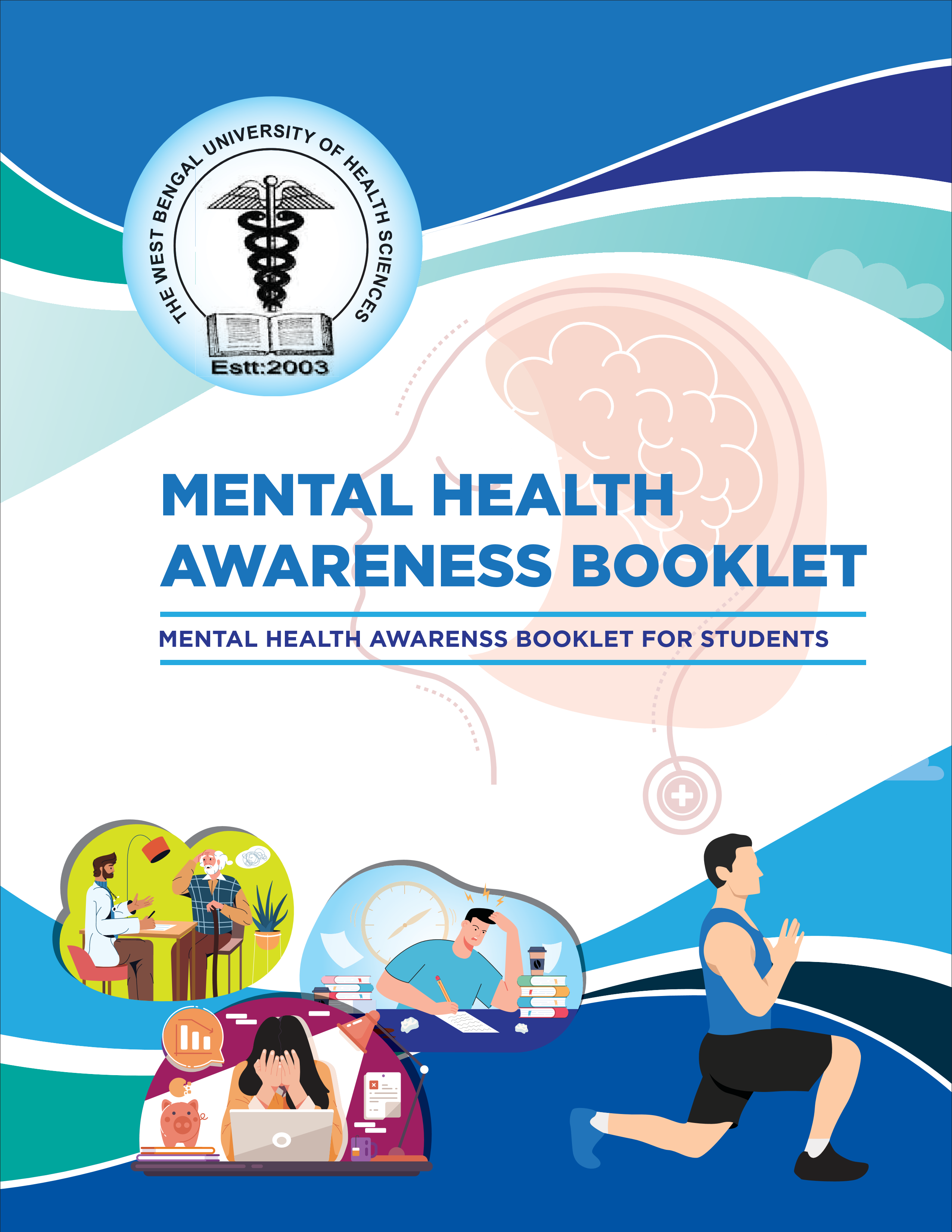- 04 Jun 2024
- 14 Минути за четене
- Сътрудници

- Печатам
- ТъменСветлина
Mental health awareness
- Актуализиран на 04 Jun 2024
- 14 Минути за четене
- Сътрудници

- Печатам
- ТъменСветлина

Mental Health Awareness Booklet
This document is prepared by
Prof. Imon Paul
Head, Department of Psychiatry
IQ City Medical College, Durgapur and
Dr. Kaustav Chakraborty
Head, Department of Psychiatry
 College of Medicine and J.N.M. Hospital, Kalyani, Nadia with inputs from
College of Medicine and J.N.M. Hospital, Kalyani, Nadia with inputs from
all Heads of the Department of Psychiatry of Medical Colleges of West Bengal.
Acknowledgement
Prof. (Dr.) Suhrita Paul, Hon’ble Vice Chancellor
The West Bengal University of Health Sciences for her continuous encouragement for the promotion of Mental Health Awareness among students


Mental Health Awareness Booklet
A. INTRODUCTION
As defined by the World Health Organization (WHO), ‘Health is a state of complete physical, mental and social well-being and not merely the absence of disease or infirmity.’ This acknowledgment of mental health as an integral component of health was also echoed by Dr. Brock Chisholm, the first Director-General of WHO, who declared in 1954 that “without mental health there can be no true physical health.”
Mental health problems can have a wide impact on all areas of life. Depression is now one of the leading causes of disability worldwide. Around 20% of the world’s children and adolescents suffer from a mental health problem while suicide is the second leading cause of death among 15-29-year-olds.
Concerns about mental health have become particularly relevant in the context of the COVID- 19 pandemic. Myriad changes in lifestyle coupled with social isolation, economic uncertainties and apprehension about the disease itself has caused a substantial increase in mental health problems.
In this background, it is of paramount importance for budding healthcare professionals to have basic mental health knowledge which would sensitize them to identify any mental health problem among themselves, family, friends and community at large, leading to early intervention.
Healthcare professionals, including medical and paramedical students form a subset of the general population who are predisposed for burnout and mental exhaustion which may lead to psychiatric problems.
 Stigma associated with psychiatric illness is a major barrier to treatment. The students can be torch bearers to remove this stigma among themselves and the general population. A significant proportion of the total caseload in primary healthcare settings involve persons with mental illnesses. Usually, these persons present with common mental health problems or as a comorbid condition of other physical disorders and are missed or inappropriately managed. Considering the huge burden of mental illnesses, it is necessary to make efforts for the inculcation of an empathetic attitude toward psychiatric disorders and psychiatry as a speciality at the undergraduate level. During training, educational interventions targeted towards them may be highly effective.
Stigma associated with psychiatric illness is a major barrier to treatment. The students can be torch bearers to remove this stigma among themselves and the general population. A significant proportion of the total caseload in primary healthcare settings involve persons with mental illnesses. Usually, these persons present with common mental health problems or as a comorbid condition of other physical disorders and are missed or inappropriately managed. Considering the huge burden of mental illnesses, it is necessary to make efforts for the inculcation of an empathetic attitude toward psychiatric disorders and psychiatry as a speciality at the undergraduate level. During training, educational interventions targeted towards them may be highly effective.
Perception and knowledge of the nursing and paramedical staff about mental illnesses is also important as they directly deal with patients and their relatives, and are also involved in disseminating health information.
Misconceptions about mental illnesses, even among healthcare professionals cause people to feel ashamed and embarrassed about their condition, leading to denial of the problem and refusal to seek help.
Mental Health Awareness Booklet
B. MYTHS ABOUT MENTAL ILLNESS
Psychiatric illness is a sign of weakness
No, there are not. Psychiatric disorders have neurobiological underpinnings and need to be treated accordingly.
Psychiatric illness means ‘Madness’
Not all psychiatric disorders are ‘madness’. Only 1% of psychiatric disorders (e.g. schizophrenia and related psychotic disorders) have symptoms of ‘madness’ or psychotic symptoms. Rest is not.
Mental health problems are permanent. You need to take medicines lifelong.
No. Not all psychiatric disorders are lifelong. Each individual’s experience with mental illness is different. The course of various psychiatric disorders can differ but many people recover to a variable degree.
• Psychiatric medications are addictive
No, they are not. These medicines need to be taken as per doctor’s advice. On sudden stoppage, some people may experience discontinuation symptoms. Therefore, the dose of these medicines needs to be tapered.
• People with mental disorders are kept in asylums
No. Most of the psychiatric disorders can be treated at home. Only few people with chronic psychiatric disorders with poor social support and homeless mentally ill people are kept / treated in asylums.
• Addiction implies lack of willpower
No, it does not. As with other psychiatric disorders, addiction has a neurobiological basis.
• All people with mental illnesses are violent.
 This is a common myth often perpetuated by erroneous portrayals in media and literature. In reality only a small percentage of people with certain psychiatric disorders become violent and unpredictable. Also, there are evidences to suggest that, ‘normal’ people are more violent compared to persons with psychiatric disorders.
This is a common myth often perpetuated by erroneous portrayals in media and literature. In reality only a small percentage of people with certain psychiatric disorders become violent and unpredictable. Also, there are evidences to suggest that, ‘normal’ people are more violent compared to persons with psychiatric disorders.
• Electro-Convulsive Therapy (ECT) or Shock Therapy is bad
ECT is not bad. When given under anaesthesia (i.e. modified ECT) it works wonder for certain severe mental health conditions. However, because of wrong portrayal by media and in movies, general people developed this idea.

Mental Health Awareness Booklet
D. COMMON PSYCHIATRIC DISORDERS
1. Depression
‘I often feel sad and low for minor reasons. Does this mean I am suffering from depression?’
Depression is a common psychiatric illness characterized by persistent and pervasive low mood, reduced interest in previously pleasurable activities, decreased energy, decreased self-confidence, decreased concentration, pessimism, ideas of guilt and worthlessness, impaired sleep and in severe cases, suicidal ideas or acts. These above-mentioned symptoms should persist for most of the time of most of the days for at least 2 weeks. Various psychosocial and environmental stressors play a major role.
Prompt identification of the signs and symptoms and early intervention can treat such episodes effectively. Medication, psychotherapy or a combination of both can be used to treat depression.
What is of concern?
Any noticeable change in behaviour
Being sad or moody
Withdrawal from others
Changes in appearance, appetite or sleep pattern
Dangerous or self- injurious behaviour
Experiencing recent trauma or life crisis
 Expressing hopelessness and desire to end life, making preparations for any such act. Threatening about committing suicide or talking about wanting to die should always be taken seriously. Not everyone who is considering suicide will say so, and not everyone who threatens suicide will follow through with it. However, every threat of suicide should be taken seriously. Any previous suicide attempt is an important risk factor for any such subsequent attempt.
Expressing hopelessness and desire to end life, making preparations for any such act. Threatening about committing suicide or talking about wanting to die should always be taken seriously. Not everyone who is considering suicide will say so, and not everyone who threatens suicide will follow through with it. However, every threat of suicide should be taken seriously. Any previous suicide attempt is an important risk factor for any such subsequent attempt.
Whom should I contact if I experience such feelings or notice such changes in a friend? Guardian/Parent/Trusted adult/ Teacher/ Mental health professional
How to take care of myself?
Consult a mental healthcare provider. Follow the prescribed treatment diligently
Regular physical exercise.
Maintain regular timing for meals and sleep.
Express your feelings to trusted friends.
Avoid abuse of substances like alcohol and nicotine.
How can I help a friend who is depressed?
Be patient, supportive and empathetic.
Listen to him/ her.
Mental Health Awareness Booklet
Do not ridicule or minimize their suffering.
Offer encouragement and hope.
Encourage them to seek treatment and help them adhere to the treatment plan.
2. Bipolar Affective Disorder
 Bipolar disorder is a mood disorder characterized by fluctuations in mood, energy, activity levels, concentration, and the ability to carry out day-to-day tasks. There may be alternating episodes of depression and manic/ hypomanic episodes. Manic episodes are characterised by elated mood, increased energy, goal directed overactivity, over-religiosity, pressure of speech, buying spree, engagement in high-risk behaviours, increased libido, decreased need for sleep. Bipolar disorder is usually diagnosed during late adolescence or early adulthood. Although the course of illness may vary over time, bipolar disorder requires long-term treatment. Bipolar disorder can affect every aspect of a person’s life, including their relationships, family and work life.
Bipolar disorder is a mood disorder characterized by fluctuations in mood, energy, activity levels, concentration, and the ability to carry out day-to-day tasks. There may be alternating episodes of depression and manic/ hypomanic episodes. Manic episodes are characterised by elated mood, increased energy, goal directed overactivity, over-religiosity, pressure of speech, buying spree, engagement in high-risk behaviours, increased libido, decreased need for sleep. Bipolar disorder is usually diagnosed during late adolescence or early adulthood. Although the course of illness may vary over time, bipolar disorder requires long-term treatment. Bipolar disorder can affect every aspect of a person’s life, including their relationships, family and work life.
3. Schizophrenia/ Psychosis
Schizophrenia and psychoses are serious mental disorders which causes significant disability. The diagnosis is associated with stigma and persons suffering from it often face discrimination. People with schizophrenia have an impaired perception of reality. Delusions, hallucinations, disorganization of thought and behaviour, difficulties with memory, attention and problem-solving abilities are often co existent. Treatment involves medication, psychoeducation, family interventions, and psychosocial rehabilitation. In most of the cases, lifelong medication is required.
Awareness among medical students and an empathetic approach is necessary to deal with the widespread stigma and discrimination.
4. Anxiety disorders
Anxiety is a normal experience. However, constant worrying, apprehension, inability to relax, overwhelming anxiety in particular situations can be indicative of pathological anxiety or an anxiety disorder. Students may have pre-existing anxious trait and with exposure to stress they can be manifested. Many students use alcohol or other substances to combat anxiety which is not only unhealthy but also compounds the problem.
Obsessive compulsive disorder (OCD) is a type of anxiety disorder characterized by obsessions (repeated, intrusive, unwanted, distressing thoughts, images and impulses) and compulsions (repetitive acts that are performed to reduce the anxiety caused by the obsession).
5. Substance misuse
Substance misuse has become rampant in the student population. Students usually abuse substances like nicotine, alcohol, cannabis as coping methods with stress. Often, they are initiated into substance use by peers which eventually leads to substance dependence. All major substances abused have lifelong psychological and physical impacts. Substance abuse can also increase impulsivity and risk-taking behaviours like unprotected sex, dangerous driving, legal problems.

Mental Health Awareness Booklet
E. STRESS MANAGEMENT MODULE
Introduction
Mental health is defined as a state of well-being in which every individual realizes his or her own potential, can cope with the normal stressors of life, can work productively and fruitfully and is able to make a contribution to his or her community.
 Stress feels uncomfortable, but not every uncomfortable feeling is stress. Stress has been dubbed the “Health Epidemic of the 21st Century” by the World Health Organization. People use the word “Stress” interchangeable with other terms such as worry, anxiety and fear, but stress is, at its heart, our conviction that we won’t be able to cope with the challenges we’re facing.
Stress feels uncomfortable, but not every uncomfortable feeling is stress. Stress has been dubbed the “Health Epidemic of the 21st Century” by the World Health Organization. People use the word “Stress” interchangeable with other terms such as worry, anxiety and fear, but stress is, at its heart, our conviction that we won’t be able to cope with the challenges we’re facing.
Stress affects the whole person, i.e., in all the human dimensions (physical, emotional, intellectual, social, and spiritual). The perception of stress and the responses to it are highly individualized, not only from person to person but also from one time to another in the same person.
Broadly, the stress is classified into two:
Eustress - good stress, is stress that benefits our health, like physical exercise or getting a promotion.
Distress - stress that harms our health and often results from imbalances between demands made upon us and our resources for dealing with these demands. The latter is what most people think about when they talk about stress. However, if handled well stress can increase motivation and stimulate us.
Stressors
Stressor can be any stimulus that causes an individual to experience stress. Three major categories of stressors are: -
Catastrophic events
Important life events (personal stressors)
Daily hassles (background stressors)
Cause of stress & its effects
Everyone has different stress triggers. Work stress tops the list. Causes of work stress include:
Being unhappy in your job
Having a heavy workload or too much responsibility
Working long hours
Having poor management, unclear expectations of your work, or no say in the decision-making process
Working under dangerous conditions
Being insecure about your chance for advancement or risk of termination
Having to give speeches in front of colleagues
Facing discrimination or harassment at work, especially if your company isn’t supportive
Mental Health Awareness Booklet
Life stresses can also have a big impact. Examples of life stresses are:
The death of a loved one
Divorce
Loss of a job
Increase in financial obligations
Getting married
Moving to a new home
Chronic illness or injury
Emotional problems (depression, anxiety, anger, grief, guilt, low self-esteem)
Taking care of an elderly or sick family member
Traumatic event, such as a natural disaster, theft, rape, or violence against you or a loved one
Sometimes the stress comes from inside, rather than outside. You can stress yourself out just by worrying about things. All of these factors can lead to stress.
Fear and uncertainty. When you regularly hear about the threat of terrorist attacks, global warming, and toxic chemicals in food, it can cause you to feel stressed, especially because you feel like you have no control over those events.
Attitudes and perceptions. How you view the world or a particular situation can determine whether it causes stress. For example, if your television set is stolen and you take the attitude, “It’s OK, my insurance company will pay for a new one,” you’ll be far less stressed than if you think, “My TV is gone and I’ll never get it back! What if the thieves come back to my house to steal again?”
Unrealistic expectations. No one is perfect. If you expect to do everything right all the time, you’re destined to feel stressed when things don’t go as expected.
Change. Any major life change can be stressful -- even a happy event like a wedding or a job promotion. More unpleasant events, such as a divorce, major financial setback, or death in the family can be significant sources of stress.
Your stress level will differ based on your personality and how you respond to situations. Some people let everything roll off their back. To them, work stresses and life stresses are just minor bumps in the road. Others literally worry themselves sick.
Effects of stress on health
 When you are in a stressful situation, your body launches a physical response. Your nervous system springs into action, releasing hormones that prepare you to either fight or take off. It’s called the “fight or flight” response, and it’s why, when you’re in a stressful situation, you may notice that your heartbeat speeds up, your breathing gets faster, your muscles tense, and you start to sweat. This kind of stress is short-term and temporary (acute stress), and your body usually recovers quickly from it.
When you are in a stressful situation, your body launches a physical response. Your nervous system springs into action, releasing hormones that prepare you to either fight or take off. It’s called the “fight or flight” response, and it’s why, when you’re in a stressful situation, you may notice that your heartbeat speeds up, your breathing gets faster, your muscles tense, and you start to sweat. This kind of stress is short-term and temporary (acute stress), and your body usually recovers quickly from it.

Mental Health Awareness Booklet
accepting sympathy from others, seeking social support, etc. Emotion focused strategies are more frequently used when stressful situation is unchangeable.
Problem-focused coping- It includes taking direct action to solve problems as well as changing or modifying the stressful problem or the source of stress. Problem focused strategy leads to change in behaviour or the development of a plan of action to deal with stress. Starting a group study to improve poor classroom performance is an example of Problem- focused coping.
Avoidance coping- In this coping style people try to minimize or avoid the threatening event. People who cope using avoidance may make enough cognitive and emotional efforts to anticipate and manage longterm problems
Coping resources
These resources can broadly be divided into:
Cognitive coping strategies and
Physical / behavioural coping strategies
Some of these coping strategies will suit some people, others will not. The key is to have a range of resources that can be applied, depending upon the situation and the individual. It is important to have strategies one is comfortable using.
Cognitive coping strategies
These refer to ways of dealing with stress using our minds. Cognitive coping strategies are a good way to combat stress-producing thoughts.
Stress management starts with identifying the sources of stress in your life
Reframing – focus on the good not the bad; think in terms of wants instead of shoulds. It’s best if our thinking is related to our goals. For example, “I want to read and understand this chapter in Chemistry so I do well in my lab practical” instead of “I have to read this difficult chapter in Chemistry”.
Challenging negative thinking – stopping the negative thoughts we may have about a situation or ourselves. Examples of negative thoughts include expecting failure, putting yourself down, feelings of inadequacy - a thought such as “Everyone else seems to understand this except me.”
In order to gain control of negative thoughts or worries, you must first become aware of them. Next, yell “Stop!” to yourself when they occur. Try replacing with positive affirmations or at least challenge or question any irrationality of the thoughts.
 Positive self-talk – using positive language and statements to ourselves. These are sometimes referred to as positive affirmations; they are useful for building confidence and challenging negative thoughts. For example, “I can do this or understand this” or “I’ll try my best”. These work best when they are realistic and tailored to your needs and goals.
Positive self-talk – using positive language and statements to ourselves. These are sometimes referred to as positive affirmations; they are useful for building confidence and challenging negative thoughts. For example, “I can do this or understand this” or “I’ll try my best”. These work best when they are realistic and tailored to your needs and goals.Count to ten – this allows you time to gain control and perhaps rethink the situation or come up with a better coping strategy.
Mental Health Awareness Booklet
Cost-benefit analysis – asking yourself questions about the worth of thinking, feeling or acting a particular way. “Is it helping me to get things done when I think this way?” “Is it worth getting upset over?” “Am I making the best use of my time?”
Keeping perspective – when under stress it is easy to lose perspective; things can seem insurmountable. Some questions to ask yourself: Is this really a problem? Is this a problem anyone else has had? Can I prioritise the problems? Does it really matter?
“Look on the bright side of life!” - Cultivate optimism.
Reducing uncertainty – seek any information or clarification you may require to reduce the uncertainty. It helps to ask in a positive way. Situations that are difficult to classify, are obscure or have multiple meanings can create stress.
 Using imagery/visualisation –imagining yourself in a pleasant or a successful situation to help reduce stress. One way to use imagery is as a relaxation tool; try to remember the pleasure of an experience you’ve had or a place you’ve been. The more senses you involve in the image the more realistic, therefore the more powerful. This strategy is often combined with deep breathing or relaxation exercises.
Using imagery/visualisation –imagining yourself in a pleasant or a successful situation to help reduce stress. One way to use imagery is as a relaxation tool; try to remember the pleasure of an experience you’ve had or a place you’ve been. The more senses you involve in the image the more realistic, therefore the more powerful. This strategy is often combined with deep breathing or relaxation exercises.
Behavioural coping strategies
These refer to ways of dealing with stress by doing something or taking action to reduce the stress experienced. Examples of these strategies are:
Physical exercise – aerobic exercise is the most beneficial strategy for reducing stress. It releases neurochemicals in the brain that aid concentration. For some people, even a short walk is sufficient to relieve stress.
Relaxation – from simple relaxation such as dropping the head forward and rolling it gently from side to side or simply stretching, to more complex progressive relaxation exercises. Progressive relaxation involves tensing and releasing isolated muscle groups until muscles are relaxed.
Breathing – from simple deep breaths to more complex breathing exercises related to relaxation and meditation.
Smile and Laugh - gives us energy and helps to lighten the load; relaxes muscles in the face.
Time management – specific strategies such as clarifying priorities, setting goals, evaluating how time is spent, developing an action plan, overcoming procrastination and organising time. These help us to cope with the numerous demands placed upon us, often a source of stress.
Social Support/Friends – encourage the development and nurturing of relationships. There is an association between good social support and a reduced risk of drop out.
Seek Help – to help us cope with unmanageable stress. This is a sign of taking control, not of weakness. There are many supports available in college for students including Student Health Service, Student Counselling Service, Mental Health Helpline, College Mentors and the Chaplaincy.


